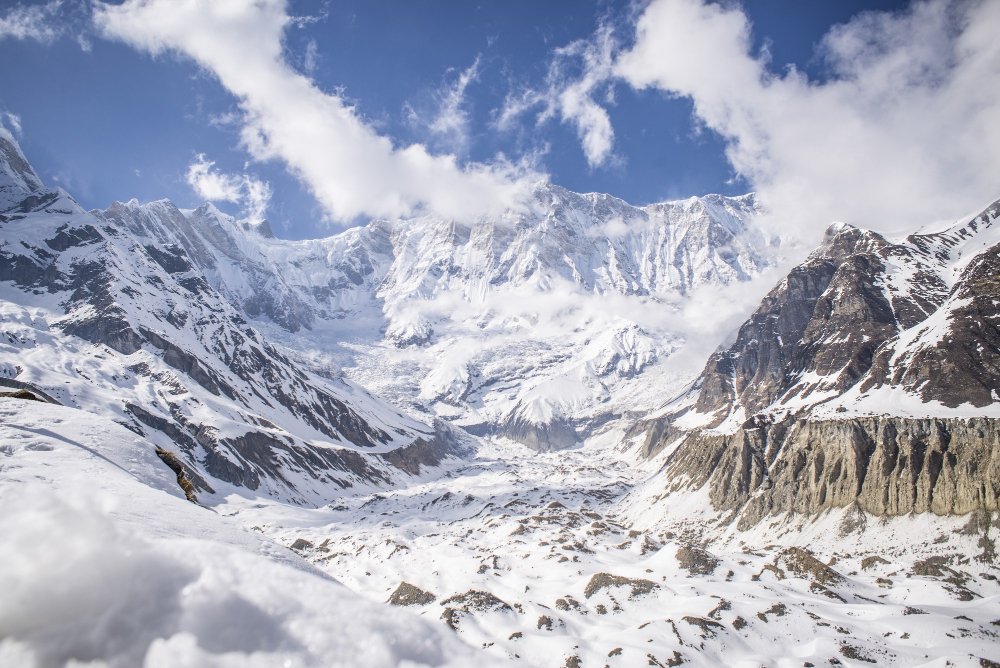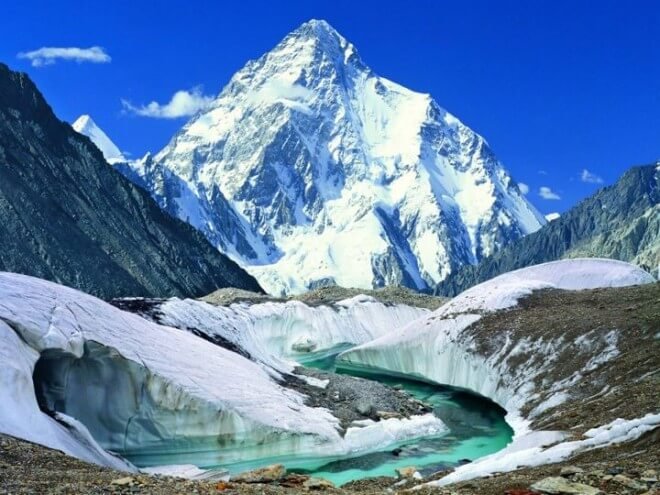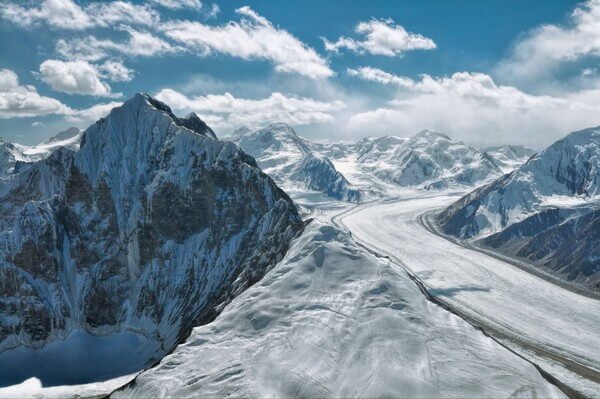
Information about the top 5 largest glaciers in the world, along with their characteristics, locations, and significance. Each glacier is a natural wonder with its own unique features and importance. Glaciers are massive bodies of ice that form over thousands of years as snow accumulates and compresses. They are found all over the world, from the Arctic and Antarctic to high-altitude mountain ranges. Glaciers play an important role in the global climate system by storing and releasing water, regulating sea levels, and influencing weather patterns.
Here are the top 5 largest glaciers in the world.
- Lambert Glacier, Antarctica
- Siachen Glacier, Karakoram Range, Himalayas
- Baltoro Glacier, Karakoram Range, Himalayas
- Fedchenko Glacier, Pamir Mountains, Tajikistan
- Malaspina Glacier, Alaska, United States
You might like: Top 5 countries with the maximum forest area
1. Lambert Glacier, Antarctica
Lambert Glacier is the largest glacier in the world by both length and width. It is located in East Antarctica and flows into the Amery Ice Shelf. Lambert Glacier measures approximately 250 miles (400 kilometers) long and about 60 miles (100 kilometers) wide at its broadest point. The glacier is named after George Lambert, an Australian airman who conducted aerial surveys of the area in the 1950s.

Lambert Glacier is a continental glacier, meaning it covers a vast portion of East Antarctica. It is primarily composed of ice, and its thickness can reach up to 2,500 meters (8,200 feet) in some areas. The glacier’s immense size and weight contribute to its slow movement, with an average flow rate of just a few meters per year.
This glacier is of particular scientific interest due to its role in transporting ice from the East Antarctic interior to the coast. It plays a crucial role in the overall ice dynamics of Antarctica and the potential impact of climate change on the region.
2. Siachen Glacier, Karakoram Range, Himalayas
Siachen Glacier is the world’s second-largest glacier located outside of the polar regions. It is situated in the eastern Karakoram Range of the Himalayas and spans approximately 76 kilometers (47 miles) in length. What sets Siachen Glacier apart is its extreme altitude, with some sections reaching elevations of over 6,000 meters (20,000 feet) above sea level.

The glacier is known for its harsh climate, with temperatures plummeting to extreme lows, often below -40°C (-40°F). It is also one of the most militarized zones in the world, as India and Pakistan both claim control over different parts of the glacier. This has led to a long-standing conflict in the region, making Siachen Glacier not only a natural wonder but also a site of geopolitical significance.
Siachen Glacier is the source of several important rivers, including the Nubra and Shyok rivers. It plays a crucial role in sustaining the water supply in the region and is a subject of concern due to its vulnerability to climate change.
3. Baltoro Glacier, Karakoram Range, Himalayas
The Baltoro Glacier is one of the longest glaciers outside of the polar regions and is located in the Karakoram Range of the Himalayas in Pakistan. It stretches for approximately 62 kilometers (39 miles) and covers an area of about 1,190 square kilometers (460 square miles).

What makes the Baltoro Glacier particularly remarkable is its proximity to some of the world’s highest peaks, including K2, the second-highest mountain on Earth. The glacier serves as a critical access route for mountaineers attempting to summit these peaks, making it a hub for Himalayan expeditions.
The Baltoro Glacier is surrounded by towering peaks and icefalls, creating a dramatic and breathtaking landscape. Trekkers and adventurers from around the world visit this region to witness its stunning beauty and challenge themselves in one of the most remote and awe-inspiring environments on the planet.
4. Fedchenko Glacier, Pamir Mountains, Tajikistan
Fedchenko Glacier is the largest glacier in the Pamir Mountains and Central Asia. It is situated in Tajikistan and covers an area of approximately 700 square kilometers (270 square miles). The glacier is known for its stunning ice formations and deep crevasses.

What makes Fedchenko Glacier unique is its location in the Pamir Mountains, often referred to as the “Roof of the World.” This region is characterized by its high-altitude plateaus and rugged terrain. Fedchenko Glacier is the primary source of the Fedchenko River, which eventually feeds into the Amu Darya, one of Central Asia’s major rivers.
The glacier is of significant scientific interest due to its role in hydrology and climate studies. It also serves as a source of freshwater for downstream communities and ecosystems, making it vital for regional water resources.
5. Malaspina Glacier, Alaska, United States
Malaspina Glacier, located in southeastern Alaska, is one of the largest piedmont glaciers in the world. It covers an area of about 3,900 square kilometers (1,500 square miles). Unlike typical valley glaciers, piedmont glaciers spread out over relatively flat terrain at the base of mountain ranges.

What sets Malaspina Glacier apart is its unique landscape. It is surrounded by lush temperate rainforests and features a complex network of ice, moraines, and meltwater streams. The glacier is a dynamic system, with ice advancing and retreating seasonally.
Malaspina Glacier is part of the larger Saint Elias Mountains and is known for its stunning scenery. Visitors can explore the region by air or by hiking along its edges, offering a chance to witness the meeting of ice and lush coastal forests.
Other largest glaciers in the word are:
- Berkner Glacier, Antarctica
- Shirase Glacier, Antarctica
- Pine Island Glacier, Antarctica
- Thwaites Glacier, Antarctica
- Pio XI Glacier, Chile
- Taku Glacier, Alaska, USA
- Columbia Glacier, Alaska, USA
- Biafo Glacier, Pakistan
- Vatnajokull glacier, Iceland
Importance of Glaciers
Glaciers play an important role in the global climate system. They store and release water, regulate sea levels, and influence weather patterns. Glaciers also provide important habitat for a variety of plants and animals.
However, glaciers are melting at an alarming rate due to climate change. This is causing sea levels to rise and is disrupting weather patterns. The loss of glaciers is also having a negative impact on the plants and animals that rely on them for survival.
What We Can Do to Protect Glaciers
There are a number of things that we can do to protect glaciers and reduce the effects of climate change. These include:
- Reducing our reliance on fossil fuels
- Switching to renewable energy sources
- Improving energy efficiency
- Protecting forests
- Reducing our carbon footprint
By taking these steps, we can help to protect glaciers and ensure that they continue to play their important role in the global climate system.



